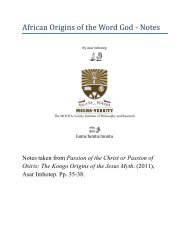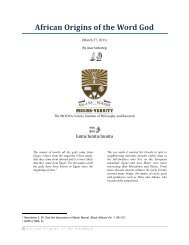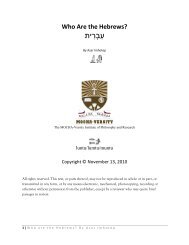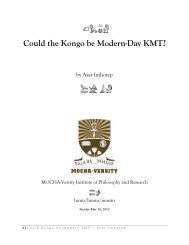reinterpretations of the ankh symbol part 2 - Asar Imhotep
reinterpretations of the ankh symbol part 2 - Asar Imhotep
reinterpretations of the ankh symbol part 2 - Asar Imhotep
Create successful ePaper yourself
Turn your PDF publications into a flip-book with our unique Google optimized e-Paper software.
4<br />
It is my belief that I have stumbled across <strong>the</strong> true inspiration behind <strong>the</strong> anx <strong>symbol</strong> in my recent<br />
eBook titled Passion <strong>of</strong> <strong>the</strong> Christ or Passion <strong>of</strong> Osiris: The Kongo Origins <strong>of</strong> <strong>the</strong> Jesus Myth (2011: 95).<br />
It is clear from my initial findings that <strong>the</strong> anx <strong>symbol</strong> was inspired by <strong>the</strong> human body and no<br />
external items can be its source. The information has been staring at us in <strong>the</strong> face this whole time.<br />
We just have to look below <strong>the</strong> surface <strong>of</strong> one’s self to see <strong>the</strong> inspiration. The following explanation<br />
also elucidates as to why <strong>the</strong> anx is <strong>of</strong>ten depicted close to <strong>the</strong> nose <strong>of</strong> deities and <strong>of</strong>ficials in ancient<br />
Egyptian artwork: it is literally associated with <strong>the</strong> breathing process, something quite essential to<br />
<strong>the</strong> maintenance <strong>of</strong> life.<br />
THE ANATOMICAL INSPIRATION FOR THE ANKH<br />
There is an ancient Egyptian proverb that states, “Know thyself and thou shalt know <strong>the</strong> gods.” They<br />
meant this literally. It is my contention that <strong>the</strong> anx <strong>symbol</strong> is simply <strong>the</strong> thorax bones <strong>of</strong> <strong>the</strong> human<br />
body. This interpretation finds support in actual Egyptian iconography. The compared image on <strong>the</strong><br />
right below is <strong>of</strong> <strong>the</strong> anx that is super imposed with <strong>the</strong> Dd Dpillar and <strong>the</strong> was Iscepter.<br />
Thorax bones in <strong>the</strong> center with “loop” surrounding<br />
<strong>the</strong> spine. The “arms” are <strong>the</strong> shoulder blades (mSkt)<br />
or collar bones (xAb, bbwy).<br />
Thorax bones compared to Egyptian anx<br />
Ancient Egyptian fusion <strong>of</strong> <strong>the</strong> anx and <strong>the</strong> Dd pillar<br />
which is <strong>the</strong> spine. We could <strong>the</strong>n interpret <strong>the</strong> was<br />
<strong>symbol</strong> in <strong>the</strong> center as <strong>the</strong> brain stem. 2<br />
What reinforces our interpretation here is <strong>the</strong> placement <strong>of</strong> <strong>the</strong> spinal column (imAx) in relation to<br />
<strong>the</strong> loop in <strong>the</strong> anx image above. The anx is nothing more than a stylized depiction <strong>of</strong> <strong>the</strong> thoracic<br />
bone structure. Because <strong>of</strong> <strong>the</strong> anx’s shape, it was hard for researchers to see its true image. The<br />
Egyptians try to depict items in <strong>the</strong> best view possible, <strong>of</strong>ten times betraying its actual likeness. A<br />
2 The brain stem is connected to your spinal cord. It’s responsible for controlling many involuntary functions,<br />
such as breathing, digestion and heart rate.






